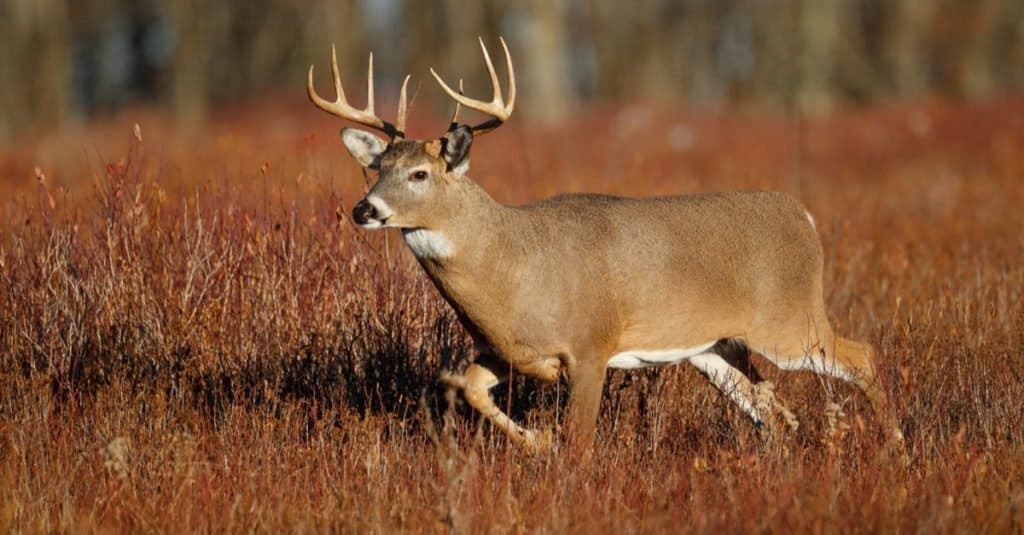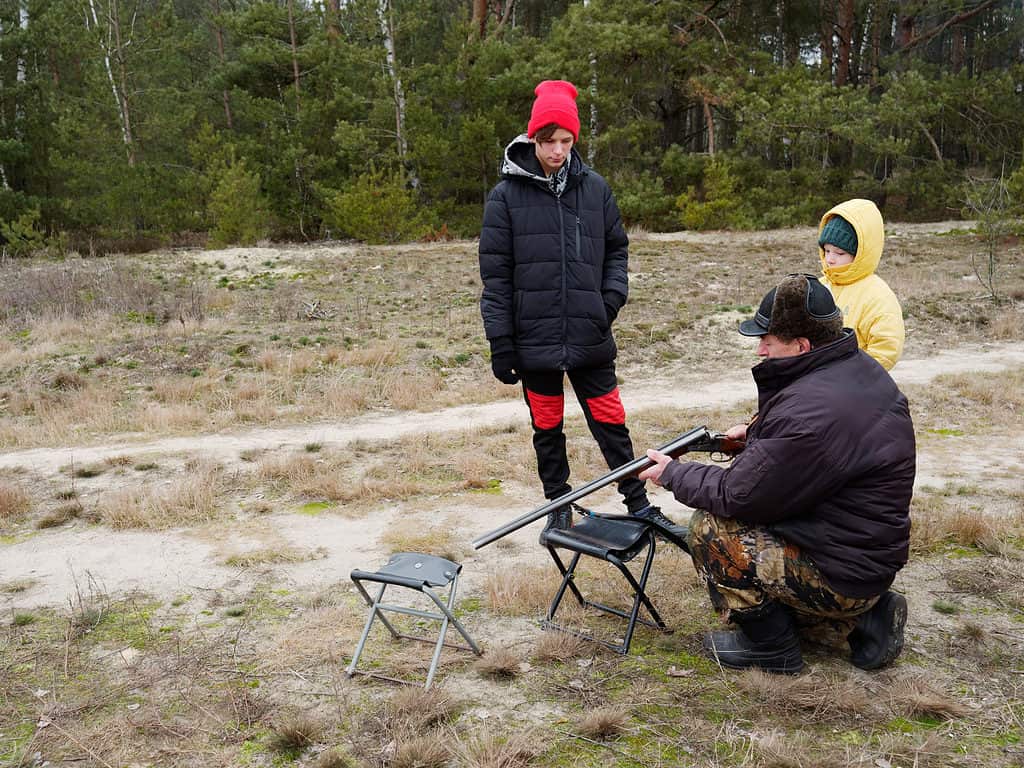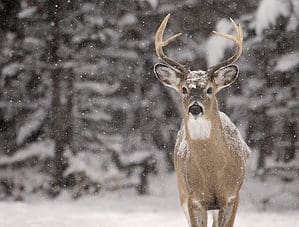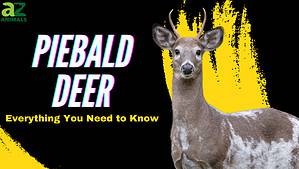Illinois is home to a large deer population, as well as several other game animals. However, to hunt in Illinois, you will have to purchase a license and abide by several regulations.
There are also several deer seasons in Illinois. Each season has different regulations, as well as different weapons that can be used. While it isn’t particularly difficult to hunt deer in Illinois, there are several requirements and regulations you must follow.
Below, we’ll discuss all the different regulations you’ll need to consider, as well as license requirements and the different deer seasons.
Hunting Licenses and Other Requirements

When hunting, you’ll need your hunting license and permits with you for inspection if required.
©Paul Tessier/Shutterstock.com
To hunt in Illinois, everyone (or almost everyone) has to purchase a license. You’ll also need to purchase any necessary stamps and permits. While there are certain exceptions, the large majority of hunters must qualify and purchase these items before hunting.
The exact licenses and permits you need can get confusing. Luckily, Illinois has a license finder that helps you figure out the exact licenses and permits you need.
All licenses are valid from January 1st of the year issued through March 31st of the following year. Therefore, they are valid for a bit longer than 12 months. When hunting, you’ll need to have your hunting license and permits with you for inspection if required. Both physical and electronic licenses are valid.
Exceptions
There are some exceptions to licensing. If you are an owner residing on farmland or their immediate family, you have the right to hunt on that land without a license. However, you cannot hunt elsewhere.
Anyone who is active duty military and is a resident of Illinois is also exempt. However, you may only hunt on leave (both ordinary and emergency). Veterans are not exempt from licensing requirements.
Those with legally documented disabilities of certain classes are also exempt from licensing requirements.
Novice Hunter Licenses
Typically, to get a license in Illinois, you must complete a hunter safety class. However, you may temporarily be exempt from this class requirement if you purchase the apprentice or youth hunting license.
The youth hunting license is for anyone under 18. With this license, the youth can hunt under the supervision of a qualified adult (who must be 21 or older and have a valid hunting license). You can continue taking the course while you have this license, which exempts you from the supervision requirement.
This license can be purchased until the hunter turns 18.
The apprentice license can be purchased once by anyone of any age. You can hunt on public property if supervised by a hunter 21 or older who has completed a hunter education course. You can hunt on private land if you are supervised by someone 21 or older, though they do not need a hunter education certificate in this case.
Hunter Safety Requirements
To get a normal hunting license, you (usually) must take a hunter safety course. Anyone born after January 1st, 1980, must take this course and receive a certificate of completion. You’ll need your identification code (which proves you passed) when getting your license.
There are two course types: instructor-led and online. The instructor-led course is traditional and the “preferred” method. It involves a 10-hour course led by an instructor. Usually, the class is a few nights a week or a full weekend class. The education material has a sixth-grade reading level. Keep this in mind when signing children up.
The class is free. However, they sometimes include special activities that the individual can choose to participate in for an extra cost (though this isn’t required). There is a test at the end of the course, which determines whether the individual passed or not.
Alternatively, you can take an online class. These classes usually cost money, as they are provided by a third party. The requirements depend largely on your age.
For those 17 years and younger, a field day is required. The hunter must take each section of the course online, as well as the exams. Then, a field day must be attended for hands-on instruction. Anyone under 10 must be accompanied during the field portion of the course by an adult.
If you’re 18 or older, then you can complete the course entirely online.
Permits

There are many types of permits for deer. Each one is only valid for certain
deer and during certain seasons
.
©iStock.com/Karel Bock
Anyone hunting deer must have a deer permit and state habitat stamp. The latter habitat stamp is only required for those 18 and older.
There are many types of permits for deer. Each one is only valid for certain deer and during certain seasons. Some must be applied for and have a limited supply. Here is a quick rundown of the different permits:
- Archery Permits: No limit for residents and can be purchased at physical vendors and online. Non-residents must apply, as there is a specific limit.
- Firearm/Muzzleloader Deer Permits for IDNR Sites: This permit must be applied for, as there is a limited number. There are several lotteries which run until there are no permits left. The first lottery is available for residents only. The second lottery is available for unsuccessful residents, residents that didn’t apply originally, and non-residents. You may only purchase five permits each.
- Late Winter Antlerless-only Permits: As the name suggests, this permit allows you to take an antlerless deer during the late winter season. Only residents can purchase this permit. You can apply for this permit. You may also switch to this permit if you have a previously unused firearm, muzzleloader, or youth season permit.
- CWD Permits: These permits are specifically for controlling CWD in deer. Therefore, the regulations vary from area to area. Only some CWD areas require you to apply for permits; others are available for direct purchase. You may also use a previously unused firearm, muzzleloader, or youth permit during this season.
- Youth Deer Permits: As the name suggests, these permits are for youths only. This permit allows youth to harvest either-sex deer in most areas. You can purchase these permits directly.
- Landowner Deer Permits: Those who own at least 39.5 acres of land can apply for a free firearm or archery deer permit. You can receive one either-sex permit and one antlerless permit in this way.
Seasonal Limits and Dates
Illinois has several seasons, and each has its own bag limit. Furthermore, each season also requires the use of specific weapons. You must also purchase the correct permit for each season.
Similarly to the permit section, here is a rundown of the different seasons:
- Archery: Archery season varies slightly between areas. However, it usually starts in early October and runs through November. Then, it starts up again in December and runs through January. You may take one deer per permit, and the sex isn’t specified.
- Firearm: During firearm season, you can also take one deer. Usually, this season is extremely short – running for only a few days in November and a few days in December. Typically, it is only over one weekend.
- Muzzleloader: During the muzzleloader weekend, you may only use a muzzleloader. However, you may take one deer per permit.
- Special CWD: During this season, you may take one deer per permit. The usual antlered deer limit does not apply.
- Late-Winter Antlerless-only: This season takes place during a weekend in December and a weekend in January. You may take one antlerless deer per permit during this season.
- Youth Firearm: During this season, you may take one deer of either sex. It is only open to youth, and a youth permit is required.
No matter what permits a hunter holds, they may only take two antlered deer per year. The “yearly” hunting season begins on July 1st, and therefore, you may only take two antlered deer from July of this year to July of the next year.
Season-Specific Regulations
There are very specific regulations for each deer season. Some areas have slightly different regulations from other seasons. Therefore, be sure to check the particular area you’re hunting in for regulations that aren’t statewide.
Archery Season
During this season, you may use several types of archery equipment. Both recurve and longbows can be used. They must have a minimum draw of 30 pounds. You must also use arrows that are at least 20″ long.
Crossbows can be used as long as they have a working safety. Furthermore, they must have a minimum draw weight of 125 pounds and a minimum length of 24″. Arrows or bolts utilized must be 14″ long.
All arrows must have broadheads that are at least 7/8″ in diameter. Both fixed and expandable arrowheads can be used. The heads must be made of metal.
During this season, you must report your fill by 10 PM the day the deer was taken. You can do this via phone or online. Be sure you’re ready to answer all the questions on the back of your permit.
Firearm Season

All hunters must wear a single blaze-orange or blaze-pink hat.
©Steve Oehlenschlager/Shutterstock.com
As you might expect, there are many weapons that can be used during firearms season. These weapons all have specific requirements, however.
Shotguns can be utilized. However, they must be gauge 10 or higher. The barrel length must be at least 18″, but the whole gun length must be less than 26″. It must not hold more than three shells at a time (including in the magazine and chamber). You can use a one-piece plug to make the gun only able to hold three shells. However, it must not be able to be removed without dismantling the shotgun.
Projectiles used must be .44 caliber.
Muzzleloaders can also be utilized. You can use both single- and double-barreled muzzleloader rifles, but they must shoot at least .45 caliber. The barrel must also be 16″ long. You can use a scope.
Centerfire, single-shot handguns can be utilized. The firearm must fire at least .30 caliber or larger, and the barrel must be at least 4″. The case length of the bullet used must not be 1.4″ or longer.
Archery weapons can also be utilized, which we discussed previously.
All hunters must wear a single blaze-orange or blaze-pink hat. You must also utilize an upper garment with at least 400 square inches of blaze orange or pink. You cannot use camo versions of these colors.
In counties without CWD surveillance, you must report your deer in the same way as archery season. However, if the area has CWD, you must physically check the deer the same day it was killed before 8 PM.
Muzzleloader Season
During this season, you may only use a muzzleloader. The requirements are exactly like the firearm season, otherwise. This includes blaze orange and blaze pink requirements.
You can also use legal archery equipment at this time. However, modern firearms cannot be utilized.
Special CWD Season
During this season, you can use any weapon legal during the firearm season. You may use archery equipment. Everyone must meet blaze orange or blaze pink requirements, as discussed in the firearm season.
This season is not open everywhere, as it is specifically made to control CWD. The two-antlered deer limit doesn’t apply to this season. You also do not have to check your deer physically at a check station. Instead, you must simply report the kill by 10 PM on the day the deer was taken. This can be done on the phone or online.
Late Winter Antlerless-Only Season
You can use any weapon during this season that you can use in firearm season. However, youth hunters may only use a shotgun or muzzleloader. You can use archery equipment. All hunters must meet blaze orange requirements – no matter what you’re hunting with.
Only certain counties are open during this season. Therefore, be sure to check where you can hunt. Only seasons with excessive deer are typically open.
Hunting requirements are similar to other seasons. You must call or report the deer online before 10 PM on the day it was killed. The questions you’re expected to answer are on the back of your permit.
Youth Firearm Season

Youth may only use a shotgun or muzzleloader and must be accompanied by an adult with a current hunting license.
©makalex69/Shutterstock.com
To hunt during this season, you must have a youth permit. Therefore, you must be under 18 years of age the day the hunt starts. This season is open only on certain sites, so be sure to check a current map for places you can hunt.
Youth may only use a shotgun or muzzleloader. They must meet the requirements we discussed above.
All youth must be accompanied by an adult with a current hunting license. The adult must maintain control of the youth at all times, which means remaining close.
The same clothing requirements discussed in the firearm season are required for this season. Both the hunter and their supervisor must meet these requirements.
All deer must be reported before 10 PM on the day they are killed. This report can be done online or through the phone.
Chronic Wasting Disease Management
Chronic Wasting Disease is a contagious, fatal disease that attacks the nervous system of animals in the cervid family, including deer. Illinois currently has many occurrences of this disease, and the state is currently attempting to slow its spread. However, because this disease lasts for a long time in the soil, this is difficult.
To help with this management, several CWD zones have been established. Deer killed in these zones are sometimes required to be tested. However, it is recommended that all deer in these zones be tested. While CWD isn’t currently reported in humans, minimizing contact with the prions that cause the disease is recommended. After all, the diseases can mutate and begin infecting other species.
Therefore, you should consider getting all deer tested. The state partners with many deer processors to encourage testing, allowing the state to control the disease easier.
Fines and Punishments for Violations
If you don’t follow hunting regulations, you could face a variety of fines or suspensions. For each offense, a certain number of points are given to the hunter. Once a certain number of points are reached, their license is suspended. A felony may be worth as many as 60 points, while a petty offense is worth 3 points.
While your license is suspended, any violation is automatically worth 60 points (including hunting without a license). Therefore, hunting while your license is suspended often means extending that suspension.
All suspensions last for one month per point once they are activated. Therefore, suspensions can last for many years for certain offenses.
Once your license is suspended in Illinois, you are not allowed to hunt in most states. Many states do communicate with each other and put offenders into a single database.
Up Next
The photo featured at the top of this post is © Tom Reichner/Shutterstock.com
Sources
- Illinois Department of Natural Resources, Available here: https://huntillinois.org/deer/
- Illinois Department of Natural Resources, Available here: https://huntillinois.org
- Illinois Department of Natural Resources, Available here: https://www2.illinois.gov/dnr/hunting/documents/revocationssuspensionsforviolations.pdf
Thank you for reading! Have some feedback for us? Contact the AZ Animals editorial team.






